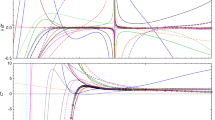Abstract
The properties of the Joule-Thomson coefficient are discussed in general for pure gases, and the possibility of a nonlinear effect in binary mixtures is analyzed using the First Law of Thermodynamics and some common cubic equations of state. It is shown that although theoretically a binary mixture of gases may exhibit a Joule-Thomson effect different from the molar-weighted mean of the pure-component effects, the possibility of observing a positive difference is very low.
Similar content being viewed by others
Author information
Authors and Affiliations
Corresponding author
About this article
Cite this article
Wisniak, J. The Joule-Thomson Coefficient for Pure Gases and Their Mixtures. Chem. Educator 4, 51–57 (1999). https://doi.org/10.1007/s00897990289a
Issue Date:
DOI: https://doi.org/10.1007/s00897990289a




